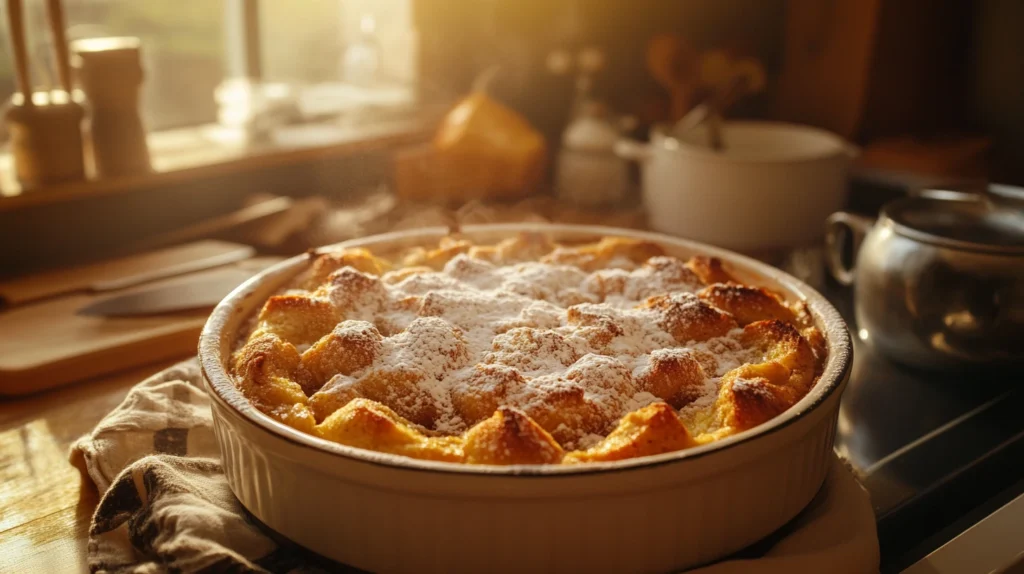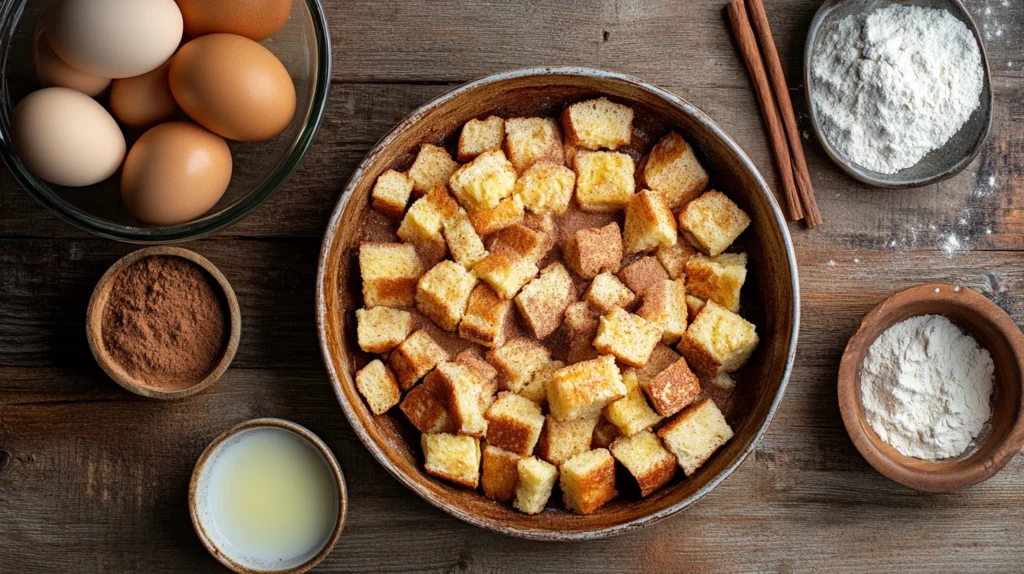When it comes to comforting breakfasts that please a crowd, nothing hits the mark quite like Sourdough French Toast Casserole. Warm, rich, and bursting with flavor, it’s the kind of dish that turns a simple morning into a special occasion. Imagine the irresistible aroma of cinnamon, nutmeg, and baked custard swirling through your kitchen as golden cubes of sourdough soak up a luscious eggy mixture before being baked to perfection.
This dish is not just another breakfast casserole; it’s a celebration of texture and taste. Whether you’re hosting a festive brunch, preparing a cozy weekend breakfast, or looking for a make-ahead solution for busy mornings, sourdough French toast casserole delivers every time. In this guide, we’ll dive deep into everything you need to know — from its delightful history and unique benefits to foolproof recipes and pro tips. Let’s get started!

What is Sourdough French Toast Casserole?
Sourdough French toast casserole is a baked breakfast dish where cubes or slices of sourdough bread are soaked in a rich custard mixture made from eggs, milk, cream, sugar, and spices. Unlike traditional stovetop French toast, this casserole is layered into a baking dish and cooked in the oven, allowing for a hands-free and hearty preparation perfect for feeding a crowd.
The beauty of using sourdough bread lies in its firm texture and tangy flavor. Sourdough holds its shape during soaking and baking, preventing the dish from becoming soggy while imparting a distinct depth of taste. Typically topped with a sprinkle of sugar, streusel, or even fresh fruit before baking, the result is a golden, slightly crispy top with a creamy, tender inside that’s simply irresistible.
Looking for another cozy bake? These Banana Nut Muffins are perfect alongside your casserole!
The Origins of French Toast and Sourdough Bread
Brief History of French Toast
Believe it or not, French toast is older than France itself! Tracing its roots back to ancient Rome, the original “pain perdu” or “lost bread” was a clever way to utilize stale bread by soaking it in milk and eggs before frying. Over centuries, cultures around the world developed their own versions, adapting ingredients based on what was locally available.
The name “French toast” actually became popular in America during the 18th century when early settlers adapted the dish. Interestingly, the “French” in the name doesn’t necessarily refer to the country, but possibly to an English cook named Joseph French who claimed the invention. Regardless of its true origin, today’s French toast—especially in casserole form—continues to charm breakfast lovers everywhere.
Sourdough Bread: An Ancient Baking Tradition
Sourdough bread boasts a history just as rich, dating back over 5,000 years to ancient Egypt. What makes sourdough unique is its natural fermentation process. Instead of relying on commercial yeast, sourdough uses wild yeast and lactobacillus bacteria, giving it a characteristic tangy flavor and chewy texture.
Traditionally, sourdough was a staple for pioneers and miners because of its durability and resistance to spoilage. Today, it enjoys renewed popularity for its artisanal appeal and potential health benefits, such as easier digestion and lower glycemic impact compared to conventional breads. When incorporated into a French toast casserole, sourdough transforms a humble breakfast into a rustic, flavorful masterpiece.
Why Choose Sourdough for Your French Toast Casserole?
When selecting the right bread for a French toast casserole, sourdough stands out as the superior choice. Its hearty crust, chewy interior, and tangy flavor elevate the dish beyond anything you could achieve with standard sandwich bread. But the reasons go far deeper than taste alone.
Nutritional Benefits of Sourdough
Sourdough bread isn’t just delicious—it’s surprisingly nutritious too. Thanks to its natural fermentation process, sourdough offers a host of health benefits that make it a smarter choice for breakfast indulgence.
First, sourdough has a lower glycemic index compared to other breads, meaning it causes a slower rise in blood sugar. This makes it a more stable option for individuals watching their sugar levels. Second, the fermentation process breaks down gluten to some extent, making sourdough easier to digest for many people. While not gluten-free, it’s often gentler on the stomach.
Additionally, sourdough contains higher levels of B vitamins, antioxidants, and beneficial lactic acid bacteria, all of which contribute to better gut health. In a dish like French toast casserole, using sourdough means you’re treating yourself without straying too far from wholesome eating.
Unique Flavor Profile and Texture
Let’s talk flavor and texture, the real stars of the show. Sourdough brings a distinct tanginess that perfectly balances the sweetness of the custard and any toppings you add, like maple syrup or powdered sugar.
While softer breads can turn mushy during the baking process, sourdough maintains a satisfying chew and structure. Its crispy edges and tender middle create an ideal contrast that’s absolutely dreamy. Plus, the subtle sour notes add an unexpected layer of complexity, making every bite a little more exciting than traditional French toast casseroles.
If you want a breakfast dish that stands out and leaves guests asking for seconds, sourdough is your golden ticket.
Essential Ingredients for the Perfect Sourdough French Toast Casserole
Creating the ultimate sourdough French toast casserole starts with assembling the right ingredients. While there’s room for creativity, sticking to high-quality basics ensures you achieve that crave-worthy result every time.
For a lighter option after your indulgent casserole, consider this Caramel Fruit Salad — fresh, sweet, and easy!
Best Types of Sourdough Bread to Use
Not all sourdoughs are created equal when it comes to French toast casseroles. Ideally, you want a rustic, hearty loaf with a thick crust and open crumb structure. Freshly baked artisan sourdoughs are your best bet. Avoid overly soft or supermarket-style sourdoughs that lack firmness—they may break apart too easily.
If possible, use day-old or slightly stale sourdough. Slightly drier bread soaks up the custard without becoming overly soggy. Some great varieties include classic white sourdough, multigrain sourdough for a nutty flavor, or even a rye blend if you’re feeling adventurous.
Must-Have Ingredients for Rich Flavor
At its core, a sourdough French toast casserole needs a few essential ingredients to shine:
- Eggs: Acts as the backbone of the custard. Large, fresh eggs are ideal.
- Milk and/or Cream: Whole milk offers creaminess, but adding a splash of heavy cream makes it even richer.
- Sweetener: Brown sugar or maple syrup brings warmth and depth.
- Spices: Cinnamon, nutmeg, and a pinch of cloves add cozy, aromatic notes.
- Vanilla Extract: A dash enhances the overall flavor profile dramatically.
- Butter: Dotting the top with butter before baking helps create a golden, luscious finish.
Optional Add-ins to Customize Your Casserole
One of the joys of making this dish is its versatility. You can easily personalize it with mix-ins to suit your tastes or the season. Here are a few ideas:
- Fruits: Blueberries, sliced bananas, diced apples, or cranberries.
- Nuts: Pecans, walnuts, or almonds for a crunchy texture.
- Chocolate Chips: For a decadent touch.
- Cream Cheese: Small dollops add a creamy surprise in every bite.
- Spices: Pumpkin pie spice or cardamom for a seasonal twist.
Mix and match these add-ins to create a custom casserole that feels uniquely yours!
Step-by-Step Guide: How to Make Sourdough French Toast Casserole

Making sourdough French toast casserole is easier than you might think, and once you get the hang of it, you’ll want to make it again and again. Let’s walk through each step to ensure a flawless, mouthwatering dish.
Preparing Your Ingredients
Start by gathering everything you need. It’s best to prepare and measure your ingredients ahead of time (this is called “mise en place” in the culinary world), making the assembly process smooth and stress-free.
Ingredients Checklist:
- 1 loaf of sourdough bread (preferably a day or two old)
- 6 large eggs
- 2 cups whole milk
- ½ cup heavy cream
- ⅓ cup brown sugar
- 2 teaspoons pure vanilla extract
- 1 teaspoon ground cinnamon
- ¼ teaspoon ground nutmeg
- A pinch of salt
- 2 tablespoons unsalted butter (for greasing the dish)
Optional Toppings:
- Powdered sugar
- Maple syrup
- Fresh berries
- Streusel topping (butter, flour, sugar mix)
Preparation Tips:
- Cube your bread into roughly 1-inch pieces. Bite-sized but not too small.
- If your bread is very fresh, you can dry it out slightly by baking the cubes in a 300°F (150°C) oven for about 10 minutes.
Assembling the Casserole
Now comes the fun part — building your masterpiece!
- Grease your baking dish generously with butter to prevent sticking and to add extra flavor.
- Layer the bread cubes evenly in the dish. If you’re using add-ins like fruits or nuts, sprinkle them between layers.
- In a large mixing bowl, whisk together the eggs, milk, cream, brown sugar, vanilla, cinnamon, nutmeg, and salt until well combined.
- Pour the custard mixture evenly over the bread, ensuring all pieces are soaked.
- Gently press down the bread with a spatula to help it absorb the custard.
- Cover with foil and refrigerate for at least 2 hours or, for best results, overnight. This long soak allows the flavors to meld and the bread to absorb all the rich custard.
Baking Tips for Perfect Texture
When you’re ready to bake, preheat your oven to 350°F (175°C).
- Bake covered for the first 30 minutes to lock in moisture and ensure even cooking.
- Remove the foil and continue baking for another 20–25 minutes, or until the top is golden brown and the center is set.
- To check doneness, insert a knife into the center. If it comes out mostly clean (a little custard is okay), it’s ready.
- Rest for 10 minutes before serving to let everything firm up slightly and make slicing easier.
Optional: Before serving, dust with powdered sugar and drizzle with warm maple syrup for a picture-perfect presentation!
A beautifully baked sourdough French toast casserole should have a crispy, slightly caramelized top and a custardy, tender middle — the best of both worlds.
Best Variations to Try

One of the reasons why sourdough French toast casserole remains a beloved dish is its incredible flexibility. You can easily adapt it to suit the seasons, special occasions, or simply your mood. Let’s explore some mouthwatering variations you’ll definitely want to try!
If you enjoy casseroles, you might also love our Keto Breakfast Casserole for a low-carb twist!
Cinnamon Apple Sourdough French Toast Casserole
Apple and cinnamon are a match made in heaven, especially when baked into a warm, cozy casserole.
How to Make It:
- Peel and thinly slice 2–3 apples (Granny Smith or Honeycrisp work well).
- Toss the apple slices with a bit of brown sugar and cinnamon.
- Layer the apples between the sourdough cubes before pouring over the custard mixture.
- Sprinkle extra cinnamon on top before baking.
The apples soften beautifully during baking, creating sweet pockets of fruitiness throughout the casserole. Add a drizzle of caramel sauce after baking for a decadent fall-inspired treat!
Berry and Cream Cheese Sourdough French Toast Casserole
For a brighter, slightly tangy version, you can’t beat a berry and cream cheese twist. This variation feels luxurious but is incredibly simple.
How to Make It:
- Scatter fresh or frozen mixed berries (blueberries, raspberries, blackberries) among the bread cubes.
- Drop small spoonfuls of softened cream cheese evenly over the berries.
- Proceed with the custard pour and baking as usual.
The cream cheese melts into creamy pockets, while the berries burst with juiciness—perfect for spring brunches or Mother’s Day breakfasts.
Savory Sourdough French Toast Casserole Ideas
Who says French toast casseroles have to be sweet? A savory sourdough French toast casserole can be a showstopper for brunch or even dinner.
Savory Variations to Try:
- Bacon, Cheddar, and Chive: Add cooked crumbled bacon, shredded sharp cheddar, and chopped chives between the bread cubes.
- Spinach and Feta: Toss in some sautéed spinach and crumbled feta cheese for a Mediterranean flair.
- Ham and Swiss: Layer diced ham and Swiss cheese for a hearty, comforting casserole.
For savory versions, omit the sugar and vanilla from the custard and instead season it with a pinch of salt, pepper, and maybe even a little Dijon mustard for depth.
These savory spins are perfect when you want something filling and rich without all the sweetness!
Make-Ahead and Storage Tips

One of the biggest advantages of sourdough French toast casserole is how wonderfully it fits into a make-ahead breakfast plan. Here’s how to prepare, store, and reheat it so you can enjoy a delicious meal with minimal effort.
How to Make It Ahead for Busy Mornings
Making this casserole ahead of time is a total lifesaver, especially if you have guests or busy family mornings.
Make-Ahead Instructions:
- Assemble the casserole completely—bread, custard, toppings—and cover tightly with foil or plastic wrap.
- Refrigerate overnight (up to 12 hours).
- In the morning, remove it from the fridge about 30 minutes before baking to take the chill off.
- Bake as directed, and voilà—fresh, hot breakfast with minimal morning work!
If you’re planning more than a day ahead, you can even freeze the unbaked casserole (instructions below).
Storing and Reheating Leftovers
Storing Leftovers:
- Cool the casserole completely after baking.
- Cover and refrigerate for up to 4 days.
Freezing Instructions:
- Wrap individual portions tightly in plastic wrap and then foil.
- Freeze for up to 2 months.
- Thaw overnight in the refrigerator before reheating.
Reheating Tips:
- For individual servings, microwave for 1–2 minutes until hot.
- For larger portions, reheat covered in a 325°F (160°C) oven until warmed through, about 20 minutes.
Proper storage and gentle reheating help maintain the casserole’s lovely texture and prevent it from drying out or becoming rubbery.
Common Mistakes to Avoid
Even though making sourdough French toast casserole is pretty straightforward, a few common mistakes can trip you up. Knowing what to watch out for can mean the difference between a good casserole and a truly unforgettable one.
Over-Soaking the Bread
It’s crucial to strike a balance when soaking your sourdough bread.
If you let it sit in the custard mixture too long without baking, the bread can become overly saturated, leading to a mushy, unpleasant texture. You want the bread to absorb enough liquid to stay moist but still maintain its structure. Pressing the bread gently into the custard and giving it a few hours (or an overnight chill) is perfect—just don’t leave it for more than 24 hours without baking.
Tip: Use day-old or slightly dried-out sourdough, which is sturdier and less likely to fall apart.
Incorrect Baking Times
Another frequent mistake is undercooking or overcooking the casserole.
If you underbake it, the center stays wet and custardy in an unappetizing way. If you overbake it, you’ll lose that lovely custardy softness, and the bread may turn tough.
Always check the casserole around the suggested baking time. Look for a set center and golden-brown top. If the middle is still jiggly, cover it loosely with foil and bake an extra 5–10 minutes.
Pro Tip: Let the casserole cool slightly before slicing. This allows the custard to finish setting, giving you clean, picture-perfect servings.
What to Serve with Sourdough French Toast Casserole
While a warm slice of sourdough French toast casserole is a meal in itself, pairing it with the right sides and toppings can create an unforgettable brunch spread.
Sweet Toppings and Syrups
Enhancing the sweetness can take your casserole to a whole new level. Some favorites include:
- Pure Maple Syrup: Classic and natural, a drizzle adds the perfect finishing touch.
- Powdered Sugar: Lightly dust for an elegant, bakery-style presentation.
- Whipped Cream: Freshly whipped cream adds a creamy, luxurious finish.
- Berry Compote: Simmer mixed berries with a little sugar and lemon for a beautiful sauce.
- Caramel Sauce: A drizzle of salted caramel over apple or pecan variations is pure magic.
Toppings are where you can get creative and adapt the casserole to fit holidays or special events!
Savory Sides for a Balanced Brunch
If you want to balance the sweetness of the casserole with something savory, here are a few stellar options:
- Crispy Bacon: Adds a salty, crunchy contrast.
- Breakfast Sausage: Spicy or sweet links pair wonderfully.
- Scrambled Eggs: A simple protein-packed side.
- Avocado Toast: A modern favorite that brings fresh flavor.
- Roasted Potatoes: Hearty and satisfying for bigger appetites.
Serving a combination of sweet toppings and savory sides ensures every guest finds something they love on their plate.
Frequently Asked Questions
Is sourdough bread good for French toast casserole?
Absolutely! Sourdough bread is one of the best choices for French toast casserole. Its sturdy structure absorbs the custard beautifully without falling apart, and its tangy flavor adds depth and character that complements the sweetness of the dish. Plus, the natural chewiness of sourdough results in a satisfying texture that stays moist without turning mushy.
What is the most common mistake in making French toast?
The most common mistake when making French toast—whether traditional or casserole-style—is over-soaking the bread. When the bread is left too long in the custard, it absorbs too much liquid and can turn out soggy or undercooked in the center. Another frequent error is not cooking or baking at the right temperature, which can cause either burning on the outside or a raw middle.
Why is my French toast casserole soggy?
A soggy French toast casserole usually happens when the bread is too fresh, too soft, or excessively soaked in custard. Another factor could be baking it at too low a temperature or not baking it long enough. To fix this, always use slightly stale or day-old bread and bake until the center is set and firm. Allow the casserole to rest before cutting to help it firm up properly.
What is the best bread for French toast casserole?
The best bread for French toast casserole is one that’s dense and hearty enough to absorb custard without breaking apart. Sourdough, challah, brioche, and French bread are all excellent choices. Day-old or slightly dried bread works best because it can soak up the rich egg mixture while maintaining its structure during baking.
Is sourdough or brioche better for French toast?
It depends on what flavor and texture you’re after! Sourdough offers a tangy, chewy bite that balances the sweetness of French toast perfectly, while brioche is richer and softer, giving you a very tender, buttery result. For a more rustic, flavorful casserole, sourdough is ideal. If you prefer something sweeter and more dessert-like, brioche might be your winner.
Why doesn’t my French toast get crispy?
If your French toast or casserole doesn’t get crispy, it’s often because there’s too much moisture in the bread or custard, or the oven temperature is too low. To encourage crispiness, try baking uncovered for the final part of the bake to allow the top to brown nicely. A few small pats of butter on top before baking can also help create a golden, crisp surface.
Conclusion

Sourdough French toast casserole is truly the ultimate comfort breakfast—easy to make, customizable, and absolutely delicious. The tangy richness of sourdough bread combined with a sweet, spiced custard transforms simple ingredients into a memorable meal perfect for any occasion.
Whether you stick to the classic recipe, explore exciting variations like berry cream cheese or savory ham and cheddar, or craft your own signature twist, this dish guarantees smiles around the breakfast table. Remember, a little planning—choosing the right bread, avoiding sogginess, and mastering the bake—goes a long way in creating a casserole that’s crispy on top, custardy in the center, and unforgettable in every bite.
Ready to wow your family and friends? Grab that loaf of sourdough, whip up your custard, and let the magic begin!

Sourdough French Toast Casserole
Equipment
- 9×13-inch baking dish
- Large mixing bowl
- Whisk
- Spatula
- Measuring cups and spoons
- Foil or plastic wrap
- Sharp bread knife
- Cooling rack (optional)
Ingredients
- 1 loaf sourdough bread about 14 oz, day-old, cubed
- 6 large eggs
- 2 cups whole milk
- ½ cup heavy cream
- ⅓ cup brown sugar
- 2 tablespoons granulated sugar optional for topping
- 2 teaspoons pure vanilla extract
- 1 teaspoon ground cinnamon
- ¼ teaspoon ground nutmeg
- ¼ teaspoon salt
- 2 tablespoons unsalted butter for greasing
- Optional: powdered sugar maple syrup, fresh berries for serving
Instructions
- Prepare the bread: Cut the sourdough loaf into 1-inch cubes. If fresh, dry the cubes slightly by baking them at 300°F (150°C) for 10 minutes.
- Grease the dish: Butter a 9×13-inch baking dish thoroughly.
- Assemble: Place half the bread cubes evenly in the baking dish. If desired, add optional fruits or nuts, then top with the remaining bread.
- Mix custard: In a large bowl, whisk together the eggs, milk, heavy cream, brown sugar, vanilla, cinnamon, nutmeg, and salt until well combined.
- Soak the bread: Pour the custard mixture evenly over the bread cubes, gently pressing down to help the bread absorb the custard.
- Chill: Cover with foil or plastic wrap and refrigerate for at least 2 hours, or preferably overnight.
- Bake: Preheat the oven to 350°F (175°C). Bake covered for 30 minutes. Remove the cover and bake for an additional 20–25 minutes, or until the top is golden brown and the center is set.
- Cool slightly: Let the casserole cool for 10 minutes before slicing and serving.
- Serve: Dust with powdered sugar, drizzle with maple syrup, and garnish with fresh berries if desired.

